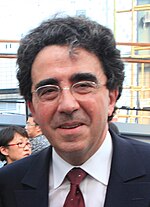Santiago Calatrava Valls
| Santiago Calatrava Valls | |
|---|---|

Santiago Calatrava in 2010
|
|
| Born |
28 July 1951 Benimàmet, Valencia, Spain |
| Nationality | Spanish |
| Education |
Polytechnic University of Valencia Swiss Federal Institute of Technology |
| Engineering career | |
| Discipline | Structural engineer, Architect, Sculptor |
| Institutions | Institution of Structural Engineers |
| Practice name | Santiago Calatrava |
| Projects |
Athens Olympic Sports Complex Auditorio de Tenerife Alamillo bridge Chords Bridge Ciutat de les Arts i les Ciències Liège-Guillemins railway station Museum of Tomorrow |
| Awards |
European Prize for Architecture AIA Gold Medal IStructE Gold Medal Eugene McDermott Award Prince of Asturias Award Auguste Perret Prize |
Santiago Calatrava Valls (born 28 July 1951) is a Spanish architect, structural engineer, sculptor and painter, particularly known for his bridges supported by single leaning pylons, and his railway stations, stadiums, and museums, whose sculptural forms often resemble living organisms. His best-known works include the Milwaukee Art Museum, the Turning Torso tower in Malmö, Sweden, the Margaret Hunt Hill Bridge in Dallas, Texas, and the Museum of Tomorrow in Rio de Janeiro, Brazil. His architectural firm has offices in New York City, Doha, and Zürich.
Calatrava was born on July 28, 1951, in Benimàmet, an old municipality now part of Valencia, Spain. His mother's family were of Jewish heritage, but had nominally converted during the Spanish Inquisition of the fifteenth century. His Calatrava surname was an old aristocratic one from medieval times, and was once associated with an order of knights in Spain. He had his primary and secondary schooling in Valencia, and, beginning in 1957, studied drawing and painting at the School of Applied Art. In 1964, as the regime of General Francisco Franco ended and Spain became more open to rest of Europe, he went to France as an exchange student. In 1968, after completing secondary school, he went to study at the Ecole des Beaux Arts in Paris, but he arrived in the midst of student uprisings and turmoil in Paris, and returned home. Back in Valencia, discovered a book about the architecture of Le Corbusier, which persuaded him that he could be both an artist and an architect.He enrolled in the Higher School of Architecture at the Polytechnic University of Valencia. He received his diploma as an architect and then did higher studies in urbanism. At the University he completed independent projects with fellow students, publishing two books on the vernacular architecture of Valencia and Ibiza.
...
Wikipedia
